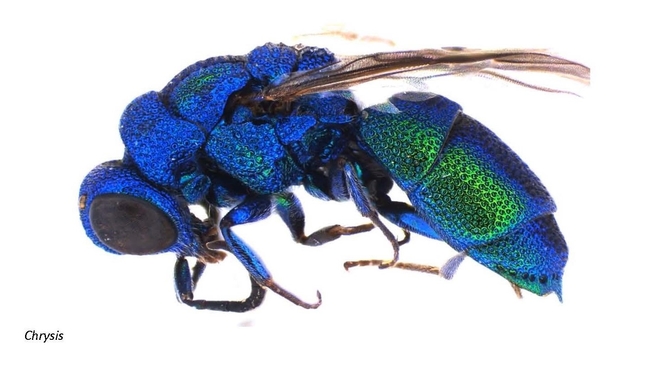- Author: Ben Faber
Bright metallic colors, flitting from flower to flower. Wasps. And they are going after other wasp species and bees. It's hard being a bee.
These wasps are parasites, and like their namesake cuckoo birds, they lay their eggs in the nests of other species (wasps or bees in this case). Since the cuckoo wasps depend on trickery and camouflage to fool their hosts, you might expect them to be drab. Scientists have not figured out whether the bright colors serve any function, and it wasn't known until 2009 that the color is actually produced by light refracting through open spaces between six layers of cuticle in the wasps' exoskeletons.
Cuckoo wasps favor warm Mediterranean climates, and California is a center of cuckoo wasp biodiversity in North America – 166 species in CA and 230 in the US. Maybe because there are so many native bee species in California is the reason there are so many cuckoo wasp species. They are most active in dry, open areas between May and August, with adults foraging on flower nectar as they follow favored routes multiple times a day searching for solitary wasps and bees to parasitize.
Cuckoo wasps are classified in the family Chrysididae, in the order Hymenoptera, and they are sometimes called Gold Wasps, Emerald Wasps or Jewel Wasps. The family name comes from the Greek, chryso, meaning gold. Besides green, they come in red, blue and purple and the thick cuticle of their exoskeleton (they are described as “heavily armored”) is often “pitted.” The common name refers to their habit of depositing their eggs in other insects' nests; a strategy practiced by birds like the Old World Cuckoos and the New World Cowbirds. Some sweat bees look similar, but cuckoo wasps tend to be “chunkier.”
Cuckoo wasps, like the majority of bees and wasps, are solitary. In highly social species like honeybees and paper wasps, there is a caste system. Since the queen is the only female that lays eggs, she is the only one outfitted with an ovipositor. And, since part of their job is defense, the workers' vestigial ovipositors have been modified into stingers. Solitary wasps need ovipositors, and many (but not all) sources say that cuckoo wasps have lost the ability to sting.
Read and see more about cuckoo wasps: The Cuckoo Wasp: A gorgeous parasite by David Lukas
And Lynn Kimsey's blog: https://ucanr.edu/blogs/blogcore/postdetail.cfm?postnum=26461




